From its roots at the turn of the 20th century, the Bureau of Reclamation has grown to be the nation’s largest water supplier and its second-largest supplier of hydroelectricity. It operates 492 dams, 338 reservoirs, and 53 hydroelectric plants and delivers water to 10 million irrigated acres across the western United States, giving it a foundational role in U.S. agriculture and in the history of the West.
Under the leadership of Commissioner Brenda Burman, Reclamation is focusing on modernizing existing infrastructure, expanding storage capabilities, promoting title transfer, and leveraging cutting-edge science and forecasting technology. It has also just released a bold new logo that visually represents the strength of water and of Reclamation’s employees and infrastructure across the West.
In this interview, Commissioner Burman gives Municipal Water Leader a panoramic view of Reclamation’s priorities for 2020 and the bold technological and infrastructural means it is pursuing in order to guarantee reliable water supplies in the West for generations to come.
Municipal Water Leader: Please tell us about your background and how you came to be commissioner.
Brenda Burman: I am honored to be the 23rd commissioner of the Bureau of Reclamation and to be working for the American people under President Trump and Secretary Bernhardt. It’s a real honor to be in this position. When I look at my background, I think I have been working my whole career to get to this job.
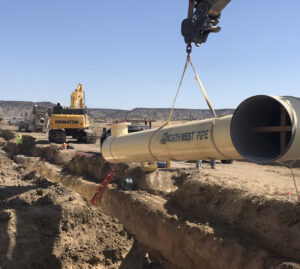
pipeline project.
I started, oddly enough, with the National Park Service in New Mexico, building trails out in the desert. You realize quickly in the New Mexico desert how exceedingly dry it is. Everything you do has to be calculated around whether there is a water supply and how you can conserve water. That’s where I fell in love with the Southwest and its water issues. After another stretch with the Park Service at the Grand Canyon, I decided to go to law school and work on water issues.
After graduating, I worked first in Wyoming and then in Phoenix for a water and energy firm, Salmon, Lewis & Weldon, where I worked on many natural resource issues, including tribal water settlements. I spent a lot of my early career working on Indian water rights settlements— agreements between neighboring communities that ensured water supply for tribal nations and their neighbors. That was incredible work, full of conflict but also incredible resolutions.
That led to working on Capitol Hill for Senator Jon Kyl of Arizona for almost 4 years. We focused not only on Arizona, but on water issues that touched California and the West as a whole. During that time, I forged the relationships that ended up bringing me to the Department of the Interior. I was deputy commissioner at Reclamation back in 2006 and then worked as deputy assistant secretary for water and science. While Interior works across the nation and internationally on important water issues, I’ve always gone back to the western United States—it is a region with special needs, and it’s where I’ve always enjoyed working.
Municipal Water Leader: Who was the commissioner when you were deputy commissioner?
Brenda Burman: John Keys recommended me for the position. Then he retired, and I worked for Bill Rinne as acting commissioner and then for Bob Johnson.
In all three—John Keys, Bill Rinne and Bob Johnson—I noted the incredible pride they had in Reclamation, in its employees, and in the work it was doing. I’m similarly proud of our work today and of our tremendous employees, who work every day to make reliable water a reality for future generations in the West.
I also appreciated the diverse backgrounds and perspectives each brought. John Keys was an engineer, Bill Rinne was a biologist, and Bob Johnson is an economist. They each leveraged their backgrounds to understand what Reclamation needed at the time to be relevant and important to the West.
They each also left their own lasting impact. John Keys—an amazing man— was ever proud of the infrastructure Reclamation had built and was working on. He had a real vision for how that infrastructure would sustain the western United States for generations to come. He truly cared for people; he strove to meet everyone involved in the department and would remember each of their names. He also had an incredible ability to work with everyone, regardless of background, perspectives, or areas of conflict.
Bill Rinne had such a disarming way about him. He could walk into the tensest negotiation and calm everyone down. He was so honest and straightforward that people couldn’t help but trust him. It didn’t matter if he was talking with a farmer, a water district manager, someone from a nongovernmental organization, a state leader, or a member of Congress—he built trust and strengthened relationships. He’d go to Capitol Hill, sometimes walking into hearings where members were criticizing something Reclamation was or wasn’t doing, and before he was done, he had disarmed and built trust with his Nebraska charm and common sense.
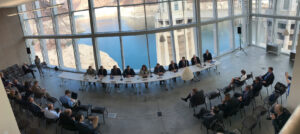
the Hoover Dam spillway house in May 2019.
Bob Johnson is such a great mentor; I’m still learning from him. He taught us that we don’t need to be stern to make a point. He was focused on trust and finding common solutions. He demonstrated that building trust with parties is the number 1 way to succeed. In 2006 and 2007, some of the toughest and most challenging years on the Colorado River, Bob brought optimism. He approached intractable issues as simply the next issue to solve. He got us through those years and led us to important agreements because stakeholders trusted him; they knew he’d always treat them fairly.
Municipal Water Leader: Most of our readers will know all about Reclamation, but for those who aren’t familiar with it, would you introduce the agency, its history, and its activities?
Brenda Burman: It’s hard to believe now, but Reclamation was created by President Theodore Roosevelt and Congress back in 1902. The idea was that the East Coast had thriving cities and agricultural communities and the West needed the same thing. It showed incredible vision that Theodore Roosevelt looked out on the West and its vast resources and recognized that if we as a nation were going to harness them, we needed reliable water supplies and federal investment in infrastructure. The Reclamation Service, later renamed the Bureau of Reclamation, built the iconic infrastructure of the West, including Hoover Dam, Grand Coulee Dam, Shasta Dam on the Sacramento River, the All-American Canal, the Columbia Basin Project, and the Central Valley Project. So much of the history of the West is tied to the history of Reclamation and its partnerships with local communities.
Today, we are the largest water supplier in the United States, even though we serve only the 17 western states. We are the nation’s second-largest supplier of hydroelectricity. While agricultural communities are our base, the areas in the West that we serve are some of the fastest growing in the United States. We deliver water to 10 million irrigated acres in the West. Those acres produce about 60 percent of the United States’ vegetables and about one-quarter of its fruit and nut crops. On the hydroelectric side, we bring clean, renewable hydroelectricity to millions of homes. I also want to highlight our recreation areas, which are often overlooked when people describe Reclamation’s activities. We have over 250 recreation sites, some of which, like Lake Mead, are among the most visited sites in the United States. Our sites get about 90 million visitors a year.
Municipal Water Leader: Please tell us about Reclamation’s top issues going into 2020.
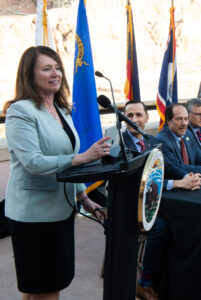
Brenda Burman: We’ve talked a little bit about Theodore Roosevelt’s great vision at the turn of the last century for what the West could become. When, in October 2018, President Trump released a memo on the reliable supply and delivery of water in the West, he was taking that vision from Teddy Roosevelt and translating it for the 21st century. How are we going to ensure reliable water and power supplies for the 21st century in the face of increasing population, increasing regulation, water scarcity, more demand, and conflict over water supplies? The Trump administration is focusing on how to make those water supplies more reliable.
We are looking at a number of ways to ensure reliable water and power supplies going into 2020. When I came on board 2 years ago, I spoke with Irrigation Leader about a few issues I thought we had to address. We talked first about drought. How are we going to face growing demand for water amid scarcity? The number 1 way we’re going to do that is by modernizing our existing infrastructure, including dams and canal delivery systems.
We also need to be looking at the future. Right now, we are relying on the infrastructure that our grandfathers and great-grandfathers built. My grandfather worked on the dams on the Deschutes River. We can’t continue to rely on the same infrastructure and expect the same results 60 or 100 years later. We’re also looking at storage. There are so many places across the West—Northern California is a prime example—where more storage is needed. Storage is what gives us certainty and flexibility, allowing us to survive dry years by collecting and holding water during wet years.
We have been working with our partners across the West to look at investment opportunities for storage. I’ll name a couple individual projects. We have been working with partners to look at raising Shasta Dam, which is at the top of the Sacramento system, by 18½ feet. It’s already 600 feet tall, so adding 18½ feet doesn’t sound like much, but with that small infrastructure addition, we could save over 600,000 acre-feet of water a year. We can currently store less than a year’s average flow on the Sacramento River. We had a nice, above-average year in 2019, but that doesn’t necessarily mean that we can deliver water to all our contractors in 2020 if it’s dry. I want that to change.
We’re also looking at other storage possibilities in California, as we have been for several years. I’ll name a few where we’re working with partners through feasibility studies. First, we are working on north-of-delta storage at the Sites Reservoir project. The Sites project is proposed as an off-stream reservoir, which certainly helps with environmental regulations. The idea is to capture flood flows and then use them in the Central Valley Project system to help meet environmental responsibilities and water supply delivery responsibilities. Many are also looking to move forward on the Los Vaqueros expansion near the Bay Delta. It would provide storage as well as redundancy—the ability to move water through the delta in a different way than we currently do. A third project is the Friant-Kern Canal. The canal has lost about 50 percent of its capacity because of subsidence. We are working with local communities to recapture the space we used to have so we can deliver our full allocations of water. That’s a very big project and it’s going to take a lot of special engineering, but we are working closely with our partners on figuring out how that could work.
Derby Dam in Nevada is another example. It was the first project designed by Reclamation, back in 1905, and is over 100 years old. It delivers water to over 50,000 acres near Fallon, Nevada. We are modernizing that dam and installing a state-of-the-art horizontal fish screen that will allow the Lahontan cutthroat trout to migrate through that system, something that hasn’t happened in more than 100 years. It’s an important partnership with the local tribes, including the Pyramid Lake Paiute Tribe, the U.S. Fish and Wildlife Service, and of course, our irrigation partners. Not only are we creating new opportunities on that river, but we’re ensuring that the water supply is reliable. The project will help ensure we can continue to deliver water to our irrigation customers by helping us meet all our environmental responsibilities.
Another example is the Navajo- Gallup Project, which will deliver water not only to the city of Gallup, New Mexico, but to the Navajo Nation and Jicarilla Apache Tribe. On-the-ground construction has been going at full pace, and we will be delivering water to part of the Navajo Nation in 2020.
We’re continuing to work on innovative and collaborative ways to finance important water projects. We recently signed a new agreement with the EPA that advances federal collaboration on funding for water supply and water reuse projects nationwide. We and the EPA will work together to implement existing water infrastructure financing programs—the EPA’s Water Infrastructure Financing and Innovation Act program and Reclamation’s Title XVI and desalination programs. That agreement will allow us to find ways to leverage funding provided by the EPA with existing Reclamation funding programs to better support the country’s water reuse and recycling projects.
Another important priority related to infrastructure is title transfer. We all know that the best managers are on the ground and local, but if infrastructure is owned by the United States, there are certain restrictions that managers have to deal with. We know that many of our partners are ready to take on their own infrastructure. They are ready to transfer the titles of their infrastructure to their local communities. In March, Congress gave us the ability to help them do that in a much smarter, more efficient, and more cost-effective way. Reclamation is taking that direction from Congress seriously. We have moved immediately to start our program and are working with several irrigation districts to transfer title. The idea is that we can do it administratively—that we don’t have to go back to Congress and ask for each single project. It is a voluntary process, and transfers have to follow certain parameters laid out in the legislation, but we are hoping we can report at the end of 2020 that several communities have taken advantage of that program and are ready to move forward.
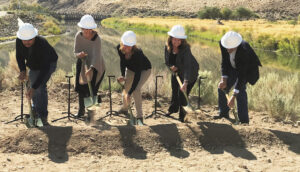
Municipal Water Leader: Please tell us about Reclamation’s new logo. What was the motivation behind developing it, and what does it represent?
Brenda Burman: Our new logo builds on our history and embodies the strength of water and the strength of our employees. This logo shows our commitment to deliver water for agriculture, for renewable hydropower, and for municipal needs in an environmentally sound manner. Our old logo was developed in a time before social media. Our new logo is part of our brand. It represents who we are. As people become familiar with it, they will think of Reclamation every time they see it.
Municipal Water Leader: Under your leadership, Reclamation has put an emphasis on stakeholder outreach. Why is this important, and how have you gone about increasing stakeholder engagement?
Brenda Burman: It is a priority of this administration and of the secretary to make sure that we are part of the community. There’s no use in the federal government sitting in Washington, DC, and telling people 2,000–3,000 miles away what to do with their water. It’s been important to me since I took office that Reclamation be accessible. Our area and regional offices, as well as our staff in Washington, need to be out there talking to people, hearing what the issues are, and hearing what needs to be done to ensure a reliable water supply. The folks here at Reclamation ran the numbers and tell me that I’ve delivered 52 speeches in the last 2 years to regional, national, and international water management audiences and that I have taken over 1,400 meetings. That number frightens me a little, but I hope that water users are seeing the results.
Municipal Water Leader: What trends do you see in western water and power today and what new technologies and advances are on the horizon for the next few years?
Brenda Burman: Looking at the future of western water, I think we need to be taking an all-of-the-above approach. In his memo, the president told us to make sure we are using the absolute best technology. In particular, the memo has a section on forecasting. We work with the U.S. Army Corps of Engineers on flood control space behind our dams, but that flood control space is controlled by certain rules, which in many places are 30–40 years old. We need to be using modern forecasting techniques so that we know when we need to release water from our storage and when we can keep it. We just had a pilot project of this nature at Folsom Dam in California. It has worked incredibly well. In this, we work closely not only with the Army Corps, but also with the U.S. Department of Commerce through the National Weather Service in California. As part of that project, we looked at what we could do with existing infrastructure to introduce these new abilities. As a result of the pilot project, we believe we’re going to be able to hold additional water behind Folsom Dam. That’s going to give added security to the communities and farmers downstream.
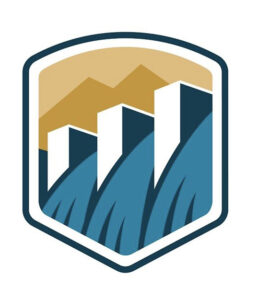
On the topic of technical expertise, I would like to focus on an area of Reclamation’s applied research that is fundamental to making sound decisions based on the best available science. For over 25 years, we’ve been an essential partner in a research and development collaboration with the University of Colorado’s Center for Advanced Decision Support for Water and Environmental Systems (CADSWES) in Boulder, Colorado. This center helped pioneer computerization of our reservoir operations and provides reliable short- and long-term hydrological forecasting based on the best available climate information. Its scientists are at the forefront of river basin modeling. Terry Fulp, regional director for the Lower Colorado Region, was one of the first participants in the program. Through our partnership with other federal agencies and academic researchers, we are advancing the science of river forecasting to help us meet the challenges in the years and decades ahead.
Municipal Water Leader: What is your vision for the future?
Brenda Burman: When I look at the future of water in the West, I’m going to go back again to say that we’ve got to take an all-of-the-above approach. We need to modernize our current infrastructure; we need to consider new infrastructure and new storage possibilities, both above ground and below ground; and we need to make advances in conservation. With all the hurdles we are facing in the 21st century, we need to know that we can deliver reliable water and power supplies. You will hear from us, just as you’ll hear from other water managers across the West, that while we must make sure that we deliver reliable water supplies this coming winter and spring and summer, most of all we need to be ready to serve the next generation. Past generations did it for us. They made sure we had the tools we needed to deliver reliable water supplies, so now it is our turn to pay it forward.
Brenda Burman is commissioner of the Bureau of Reclamation. She can be contacted at publicaffairs@usbr.gov. 
